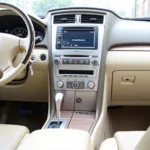The automotive world can be a confusing place, especially when it comes to understanding the diagnostic trouble codes (DTCs) your BMW displays. If you’ve ever wondered about the mysterious “BMW code crossover to OBD2,” you’re not alone. This transition reflects the evolution of car diagnostic technology and how we troubleshoot those pesky engine lights.
From BMW-Specific Codes to Universal OBD2
Before the mid-1990s, BMWs, like many other car manufacturers, used their own proprietary diagnostic systems and corresponding trouble codes. This meant that specialized equipment, often found only at dealerships or specialized mechanics, was needed to read and understand what was wrong with your vehicle. Imagine the frustration of seeing a warning light and having no way to easily decipher its meaning!
Enter OBD2, short for On-Board Diagnostics, second generation. This standardized system, implemented in the US in 1996 and adopted globally, revolutionized car diagnostics. OBD2 mandated a universal connector and a common set of codes across all car makes and models. This meant that instead of needing expensive, brand-specific tools, you could now use a much wider (and often more affordable) range of OBD2 scanners to read your BMW’s engine codes.
But what does this transition mean for BMW owners? While BMW still uses some manufacturer-specific codes for more in-depth diagnostics, the most common and essential engine codes have a corresponding OBD2 code. This allows you to use a standard OBD2 scanner to identify common issues like:
- Engine misfires
- Oxygen sensor malfunctions
- Emissions control system problems
- Transmission issues
How to Use an OBD2 Scanner on Your BMW
Using an OBD2 scanner is straightforward. Here’s a quick guide:
- Locate your BMW’s OBD2 port. It’s typically found under the dashboard on the driver’s side.
- Plug the OBD2 scanner into the port.
- Turn your car’s ignition to the “on” position (don’t start the engine).
- The OBD2 scanner will power on and connect to your car’s computer.
- Select “Read Codes” or a similar option on the scanner.
- The scanner will display any stored trouble codes.
Deciphering the Codes: What Do They Mean?
OBD2 codes follow a standard format. Let’s break down an example: P0420
- P: Indicates a powertrain-related code.
- 04: Refers to a specific system or component (in this case, the catalytic converter).
- 20: Specifies the particular problem within that system.
To understand what “P0420” means, you’d consult an OBD2 code chart or database. These resources provide detailed descriptions of each code, helping you understand the potential causes and solutions for the issue.
“Remember, while an OBD2 scanner can point you in the right direction, it’s not a replacement for a qualified mechanic. If your BMW is experiencing persistent issues, a professional diagnosis is always recommended.” – Michael Carter, ASE Certified Master Technician
Beyond Basic Codes: Advanced Diagnostics for Your BMW
For more complex issues or to access BMW-specific codes, you’ll need a more advanced diagnostic tool. Options include:
- BMW-Specific Scanners: These offer in-depth access to all BMW systems and codes, including manufacturer-specific ones.
- Software Applications: Programs like INPA or ISTA, combined with a compatible cable, provide comprehensive diagnostic capabilities on your laptop.
These tools allow access to live data streams, component activation tests, and advanced troubleshooting procedures. However, they require more technical knowledge and are typically used by experienced DIYers or professionals.
FAQs about BMW Code Crossover to OBD2
1. Can I use any OBD2 scanner on my BMW?
Yes, most standard OBD2 scanners will work with your BMW to read and clear common engine codes. However, for more advanced diagnostics or to access BMW-specific codes, you’ll need a specialized scanner or software.
2. Why does my BMW still display a warning light even after clearing the codes?
If the underlying problem hasn’t been fixed, the warning light will likely reappear. Simply clearing the codes doesn’t resolve the issue itself.
3. Where can I find reliable information about OBD2 codes?
OBDFree offers a comprehensive database of OBD2 codes, along with their descriptions and potential causes. You can also find helpful resources on reputable automotive forums and websites.
Need Help with Your BMW’s Engine Codes?
Still feeling lost in the world of BMW codes and OBD2? Our team at OBDFree is here to help! Contact us via WhatsApp at +1(641)206-8880 or email us at [email protected]. Our 24/7 customer support team is standing by to answer your questions and guide you towards the right solution.


